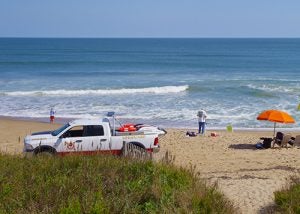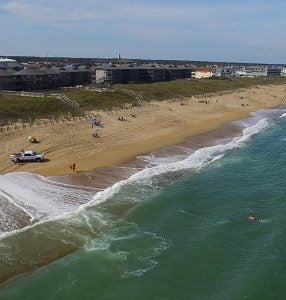OCEAN OUTREACH
Rip current project aims to raise awareness, save lives
For years, beachgoers have learned to “break the grip of the rip” by swimming parallel to shore to escape currents pulling them out to sea. Now a partnership of researchers, scientists and lifeguards is taking that public awareness push to the next level by teaching people to avoid rip currents in the first place.
The partnership began when Greg Dusek, senior scientist with the National Oceanic and Atmospheric Administration, was a UNC-Chapel Hill graduate student doing his dissertation research on rip currents at the UNC Coastal Studies Institute (CSI).
East Carolina University is the administrative campus for CSI, which was founded in 2003 and also includes member institutions Elizabeth City State University, N.C. State University, UNC-Chapel Hill and UNC-Wilmington. “CSI really helped with all of the field work,” Dusek said. “We deployed wave gauges over the course of two summers, and studied the shape of the bottom.”
The Army Corps of Engineers research facility in Duck also helped with the research, as did lifeguard agencies on the Outer Banks.
“We wanted to better predict rip currents, and to do that we needed some direct observation,” said Dusek. “The lifeguards are out there every day, and they have collected a lot of data for us – records of their rescues over eight or nine summers.”

Rip currents are easier to identify from an elevated perspective like a beach access, as seen here in Kill Devil Hills.
Today Dusek works for NOAA’s National Ocean Service, and together with the National Weather Service, the data he collected is being used to develop a model to predict rip currents. The model will be used to produce beach forecasts, which are now in an experimental stage, and to issue warnings when there is a high likelihood of dangerous rip currents.
Kill Devil Hills Ocean Rescue Supervisor David Elder’s department is responsible for guarding five miles of beach along North Carolina’s Outer Banks, and he said rip currents are the single major factor in most rescues.
In trying to educate the public about rip currents, he said, “We started to realize that it isn’t as easy to fix as ‘do this and that will happen.’ If you were to take any one action – float in place, or swim left, or swim straight in – no one of those is going to be effective every time. And you can’t count on everyone in the water being a strong swimmer.”
The best way to protect people from rip currents, he said, is with information. That can take many forms, from learning to recognize rip currents to speaking with a lifeguard about current conditions. The beach forecasts are intended to add to that knowledge base.
In addition to the rip current model, the partnership has put together an outreach campaign to expand the public knowledge of rip currents, including a series of educational videos with footage produced by CSI.
“We’ve helped produce some imagery and content to rebrand the message that’s being used for rip current safety nationwide,” said John McCord, CSI’s director of public engagement. “We’re interested in having people be able to identify currents before they’re in the water to avoid getting into it. Many times the cues are very subtle.”
CSI shot video footage of rip currents from a variety of perspectives – from the beach, from the dunes and from a drone – both with and without fluorescein dye that helps show the current.
“You can see the track out and the plume at the end, especially in the footage from the drone,” McCord said. “We want to show people what they look like during conditions that can be the most dangerous.”
Since fewer people are in the water during rough, stormy weather, it’s actually calmer conditions that can be more dangerous. Rip currents are most common at low tide, with a well-formed sandbar near the beach. Wherever there are gaps in the bar, rip currents can form.

Rip currents are the cause of most lifeguard rescues, said Kill Devil Hills Ocean Rescue Supervisor David Elder. Lifeguards use flags to mark locations where dangerous currents have been identified.
Another thing to look for is places where the waves aren’t breaking – flat spots in the line of breaking waves. This is easier to see from an elevated position, so check from the dunes or the boardwalk before going down to the beach. Look for flags marking danger areas.
Other tips include self-awareness – recognizing the level of your own swimming ability – and tailoring water activities to the weakest swimmer in the group. If someone is in trouble, get a flotation aid to them and alert a lifeguard, but avoid going in after them. Would-be rescuers often get in trouble, as well.
“They are pulling people out of the water day after day from these rip current events,” McCord said. “Even while we were shooting, they had to pull someone out, so the shot that’s in the PSA is a real rescue. They have a daily challenge in trying to educate the public.”
Dusek said the partnership has been instrumental in putting together the forecast model. “Without their assistance we wouldn’t have had a chance to develop this program,” he said.
The Rip Current Survival Guide produced by NOAA’s Ocean Today program is available at http://oceantoday.noaa.gov/ripcurrentfeature/.
Rip current survival video courtesy of the National Oceanic and Atmospheric Administration – U.S. Department of Commerce.